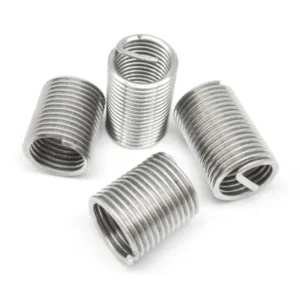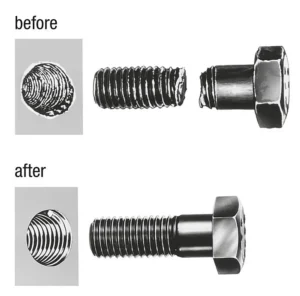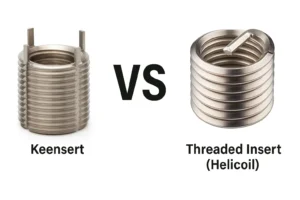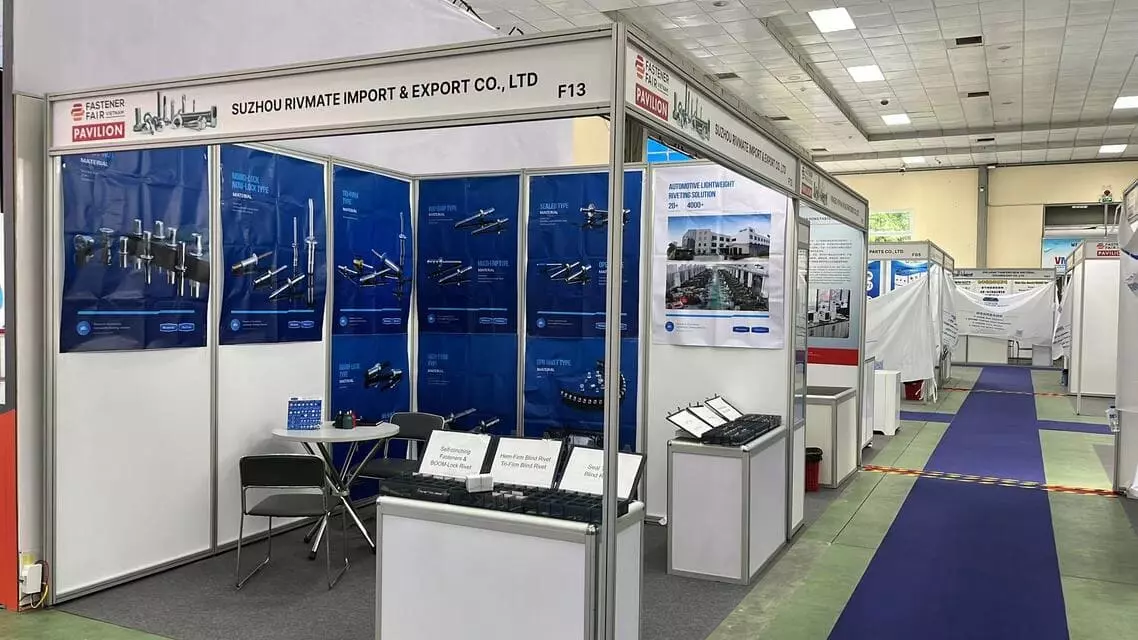Purchasing Rivet Nuts or Rivet Nut Tools: Key Factors to Consider
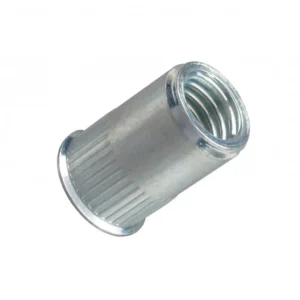
Leading Rivet Nut Manufacturer and Supplier in China

When it comes to purchasing rivet nuts or rivet nut tools, making an informed decision is crucial to ensure you get the best quality, performance, and value for your project. Whether you’re involved in a small DIY project or managing large-scale industrial production, understanding the key factors that influence your purchase can help you avoid costly mistakes and streamline your procurement process. In this blog, we’ll explore the most important considerations you need to keep in mind when selecting rivet nuts and the tools needed to install them, helping you make the right choice for your specific requirements.
Table of Contents
Key Factors in Choosing Rivet Nuts
Material Types of Rivet Nuts
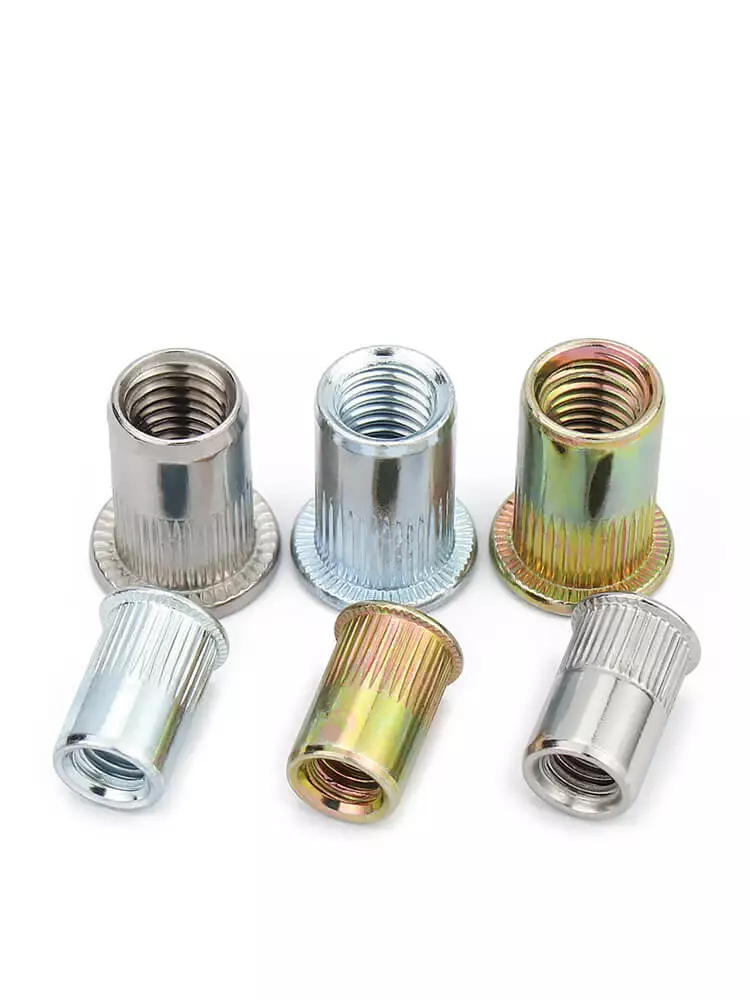
The choice of material for rivet nuts directly impacts their strength, corrosion resistance, weight, and suitability for various environments. The most common materials for rivet nuts in the market include carbon steel, stainless steel, and aluminum alloy, each offering unique advantages and applications.
Carbon steel rivet nuts are typically made from low-carbon steel or medium-carbon steel, offering high strength, moderate cost, and the ability to withstand significant torque and tensile forces, making them widely used in many industrial applications.
Advantages:
- High Strength: Compared to aluminum alloy rivet nuts, carbon steel can withstand higher axial pull-out and torque, making it suitable for high-load applications.
- Lower Cost: Carbon steel rivet nuts are more cost-effective than stainless steel, making them ideal for mass production.
- Electroplating Options: The surface can be treated with zinc, nickel, or chrome plating to improve corrosion resistance and aesthetics.
Disadvantages:
- Prone to Rust: Without additional surface treatment, carbon steel is vulnerable to rust from exposure to moisture, acids, and alkalis.
- Lower Corrosion Resistance: Compared to stainless steel, carbon steel has a shorter lifespan in salt spray, humid, or chemically corrosive environments.
Stainless steel rivet nuts are primarily made from 304 (A2) or 316 (A4) stainless steel, known for their excellent corrosion resistance and good mechanical properties, making them suitable for demanding industrial and outdoor applications.
Advantages:
- Excellent Corrosion Resistance: Stainless steel can withstand long-term exposure to moisture, acids, alkalines, and salt spray without rusting.
- Higher Strength: Compared to aluminum alloy, 304 and 316 stainless steel offer better tensile and torsional strength.
- High Temperature Resistance: Suitable for high-temperature environments, such as engine compartments and boiler equipment.
Disadvantages:
- Higher Cost: Stainless steel is more expensive than carbon steel and aluminum alloy.
- Harder Material, More Difficult Installation: Due to its hardness, installation on thin sheets or softer materials may require higher force or specialized equipment.
Aluminum rivet nuts are known for being lightweight and highly corrosion-resistant, making them ideal for applications where weight is critical, such as aerospace and new energy vehicles.
Advantages:
- Lightweight: With a density that is only one-third of carbon steel and stainless steel, aluminum alloy is perfect for products that require weight reduction.
- Good Corrosion Resistance: Aluminum naturally forms an oxide layer that protects it from corrosion in regular environments.
- Good Conductivity: Suitable for applications that require electrical conductivity, such as electronic devices and 5G communication equipment.
Disadvantages:
- Lower Strength: Compared to carbon steel and stainless steel, aluminum alloy has lower strength and is not suitable for handling excessive loads.
- Prone to Deformation: Due to its softness, aluminum may damage threads when tightened under high torque.
Thread Sizes and Matching Hole Sizes
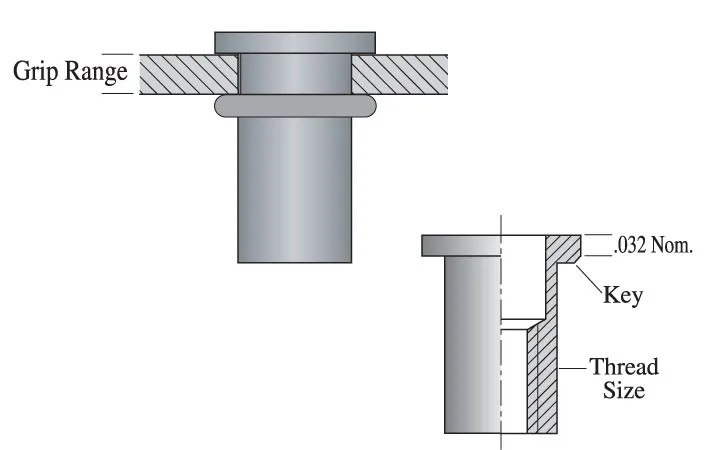
The thread specifications for rivet nuts usually include sizes such as M3, M4, M5, M6, M8, M10, M12, etc. When selecting the appropriate thread specification, factors such as drill bit size, thread strength, base material thickness, and installation space need to be considered to ensure a stable and reliable connection.
To install a rivet nut, a proper hole size must first be drilled into the base material. Each rivet nut specification requires a specific drill bit size. If the hole is too large, the rivet nut may loosen or fail to set properly. If the hole is too small, installation may be difficult, or it may damage the rivet nut or the base material.
| Rivet Nut Size | Recommended Hole Size |
| M3 | 4.5 mm |
| M4 | 6.0 mm |
| M5 | 7.0 mm |
| M6 | 9.0 mm |
| M8 | 11.0 mm |
| M10 | 13.0 mm |
| M12 | 15.0 mm |
2. Thread Strength Requirements
The selection of thread specifications directly affects the rivet nut’s load-bearing capacity. The larger the specification, the higher the pull-out and torque resistance.
| Thread Size | Pull-Out Force (kN) | Torque Strength (Nm) |
| M3 | 3.0 – 4.5 kN | 4 – 6 Nm |
| M4 | 5.0 – 7.5 kN | 7 – 10 Nm |
| M5 | 8.0 – 11.0 kN | 12 – 15 Nm |
| M6 | 12.0 – 18.0 kN | 18 – 25 Nm |
| M8 | 20.0 – 30.0 kN | 25 – 35 Nm |
| M10 | 30.0 – 45.0 kN | 40 – 55 Nm |
| M12 | 40.0 – 60.0 kN | 55 – 75 Nm |
3. Considerations for Installation Space
The installation space for rivet nuts mainly includes material thickness, available surrounding space, and compatibility with installation tools.
(1) Base Material Thickness Requirements
- Each rivet nut size has a corresponding range for the thickness of the material to be used, typically between 0.5mm – 6.0mm.
- If the base material is too thin, the rivet nut may fail to form a strong attachment, leading to loosening or damage. If the material is too thick, the rivet nut may not deform and fasten completely.
- Optional Solution: For thicker base materials, long-style rivet nuts can be used to accommodate deeper installation environments.
(2) Available Installation Space
- Narrow spaces (such as cabinets, inside equipment): Small thread sizes (M3-M5) are recommended, along with manual or small electric rivet nut tools for installation.
- Open spaces (such as large steel structures, vehicle chassis): Larger thread sizes (M6-M12) can be used, along with pneumatic or hydraulic rivet nut tools to improve installation efficiency.
Selection Recommendations:
- If installation space is limited, smaller thread sizes and compact tools should be prioritized.
- For larger thread sizes in restricted spaces, closed-end or reduced-head designs are preferable to accommodate compact structures.
Head Type
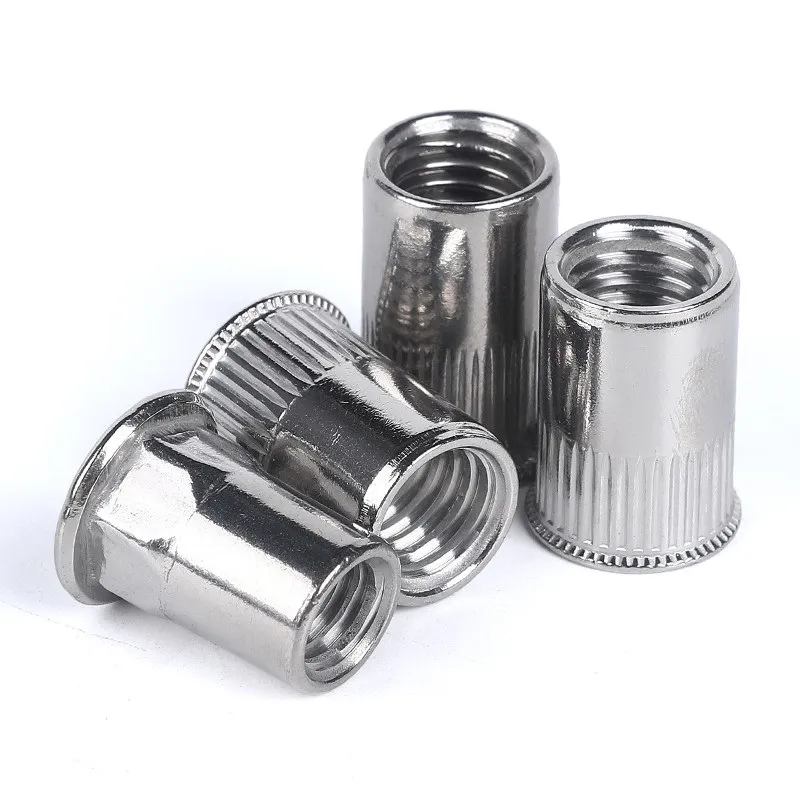
Features:
- Has a larger flange, which is exposed on the surface of the base material after installation.
- The flange diameter is typically larger than the thread size, providing a larger contact area, distributing the force, and enhancing the stability of the connection.
- Suitable for most metal sheet materials, and can enhance pull-out resistance to prevent the rivet nut from loosening on the base material.
Application Scenarios:
- Sheet metal structures (such as machinery enclosures, automobile bodies)
- High-load connections (such as rail transport, building curtain walls)
- Soft base materials (such as aluminum sheets, plastic panels), to prevent the nut from embedding too deeply.
Features:
- The head is designed to be cone-shaped, allowing it to be embedded into a conical hole in the base material, making the nut flush with the surface after installation.
- Provides a smoother surface after installation, without affecting the appearance or subsequent installations.
- Suitable for applications requiring a smooth surface finish to avoid protruding nuts that affect the structure.
Application Scenarios:
- Electronic device enclosures (such as server cabinets, instrumentation)
- Panel connections (such as control panels, display screen frames)
- Applications requiring high aesthetics (such as furniture decoration, architectural decoration)
Features:
- The head is smaller than the standard flat head, occupying less space, making it ideal for confined installation spaces.
- Suitable for thinner base materials, reducing the impact on the material surface while providing a reliable threaded connection.
- Due to the smaller flange, the contact area is smaller than that of flat head rivet nuts, potentially requiring higher installation precision.
Application Scenarios:
- Thin-walled materials (such as composite materials, plastics, thin metal sheets)
- Compact structures (such as tubular frames, aerospace components)
- Lightweight design needs (such as new energy vehicles, drones)
Summary: How to Choose the Correct Head Type for Rivet Nuts?
- For high strength and stability, the Flat Head is recommended, suitable for high-load scenarios like machinery equipment and automotive manufacturing.
- For applications requiring a smooth surface finish, choose the Countersunk Head to ensure the nut is flush with the base material, ideal for electronic devices and decorative panels.
- For limited installation space, the Reduced Head is recommended to minimize space usage, suitable for thin-walled materials or lightweight design applications.
Body Type

Features:
- Simple structure, suitable for standard fastening needs.
- Suitable for most metal and plastic sheets, easy to process, and cost-effective.
- Due to its smooth surface, there is a potential risk of spin-out failure in high vibration or high torque environments.
Application Scenarios:
- General industrial applications (such as electronic devices, household appliances, lightweight structures)
- Low-load scenarios (such as thin metal sheets, plastic part connections)
- Environments where anti-rotation is not critical
Features:
- Best anti-rotation performance, the nut body is hexagonal, allowing it to perfectly match corresponding hexagonal holes, preventing the rivet nut from rotating or loosening during use.
- Suitable for softer or thicker materials, such as aluminum sheets, plastics, composite materials, which are more prone to deformation. The hexagonal structure provides better fixation.
- Requires hexagonal holes, which demands higher processing accuracy, requiring punching or laser cutting before installation.
Application Scenarios:
- High vibration environments (such as automobiles, railways, machinery equipment)
- Softer or thicker base materials (such as aluminum sheets, plastics, composite materials)
- High-strength fastening needs (such as building structures, aerospace)
Features:
- The knurled surface texture significantly increases friction, enhancing the rivet nut’s fixation in the base material and reducing the risk of loosening due to vibration or impact.
- Suitable for applications requiring high anti-slip performance, such as machinery equipment and vibration-prone environments.
- The knurled structure increases friction between the nut and base material, eliminating the need for hexagonal holes, making installation more convenient.
Application Scenarios:
- High vibration equipment (such as machinery, engine mounts)
- Applications requiring high anti-slip performance (such as tool cabinets, electrical enclosures)
- Suitable for metal and plastic substrates
Summary: How to Choose the Right Rivet Nut Body ?
- For general applications and low-cost requirements: Choose Smooth Round Rivet Nuts, suitable for sheet metal, electrical enclosures, and other low-load environments.
- For high vibration environments with strong anti-rotation needs: Choose Hexagonal Rivet Nuts, ideal for industries like automotive and rail transport.
- To increase friction and reduce loosening risk: Choose Knurled Rivet Nuts, suitable for machinery equipment, motor mounts, and other high-vibration applications.
Base Material Types
- Metal Materials: Steel sheets, stainless steel sheets, aluminum sheets, etc. It is recommended to use hexagonal or knurled rivet nuts to enhance anti-rotation capability.
- Plastic: Lighter aluminum alloy or specially knurled rivet nuts should be chosen to prevent plastic deformation or cracking.
- Composite Materials: Such as carbon fiber, fiberglass, it is recommended to use knurled rivet nuts to increase friction.
- Wood: Larger flange rivet nuts can be used to increase the contact area and avoid pull-out.
Do You Have Any Questions?
Let Us Solve Your Problem
Key Factors in Choosing Rivet Nut Tools

1. Comparison of Rivet Nut Guns
| Tool Type | Applicable Rivet Nut Sizes | Advantages | Disadvantages | Suitable Scenarios |
| Manual Rivet Nut Gun | M3-M8 | Low cost, portable | Requires more manual force, lower efficiency | DIY, low-frequency repairs, small batch production |
| Pneumatic Rivet Nut Gun | M3-M12 | Fast speed, suitable for high-volume production | Requires air source, higher maintenance cost | Automotive manufacturing, mechanical processing, assembly lines |
| Electric Rivet Nut Gun | M3-M12 | Easy operation, high portability | Higher cost, limited battery life | On-site installation, mobile operations, maintenance |
| Hydraulic Rivet Nut Gun | M6-M20 | Suitable for large rivet nuts, high-strength fastening | Expensive, bulky equipment | Aerospace, heavy machinery, construction steel structures |
How to Choose the best rivet nut tools?
- Small Sizes (M3-M6) → Choose manual or electric rivet nut guns
- Medium Sizes (M6-M12) → Choose pneumatic or electric rivet nut guns
- Large Sizes (M12-M20) → Choose hydraulic rivet nut guns
- High-Volume Production (>1000 units/day) → Choose pneumatic or hydraulic rivet nut guns
2. Tool Type Matching for Different Rivet Nut Sizes
Different rivet nut sizes require corresponding tools to ensure quality and efficiency. For example:
- M3-M5 Rivet Nuts: Suitable for manual or small electric rivet nut guns, as they require less installation force and are used for light-duty metal connections.
- M6-M10 Rivet Nuts: Recommended to use pneumatic or electric rivet nut guns, as they offer faster installation speeds for medium-load applications.
- M12-M20 Rivet Nuts: Suitable for hydraulic rivet nut guns, which provide sufficient riveting force for fastening large structural components.
Usage Recommendations:
- Thin Sheet & Small Rivet Nuts (M3-M5) → Choose lightweight tools (manual, electric)
- High Strength Requirements (M8-M12) → Choose medium-sized tools (pneumatic, electric)
- Heavy-Duty Applications (M12 and above) → Choose hydraulic tools
3. Tool Selection for High-Volume vs Low-Frequency Use
Low-Frequency Use (Maintenance, DIY, Temporary Installation)
- Choose manual rivet nut guns or small electric rivet nut guns for minimal installation needs.
- Suitable for home repairs, furniture installation, small metal structures.
- Low investment cost but lower efficiency.
Medium-Volume Production (Industrial Assembly, Mechanical Manufacturing)
- Choose electric or pneumatic rivet nut guns for a balance of speed and ease of use.
- Suitable for electronic enclosures, automotive parts, metal equipment assembly.
- Moderate speed and cost, suitable for everyday use.
High-Volume Production (Factory Assembly Line, High-Intensity Operations)
- Choose pneumatic or hydraulic rivet nut guns for fast installation speeds, ideal for production lines.
- Suitable for automotive manufacturing, rail transport, aerospace, steel structure engineering.
- High initial investment but efficient long-term operation and reduced labor costs.
4. Durability, Ease of Use, and Maintenance Costs
Durability
- Manual Tools: Simple structure, low maintenance cost, but hand fatigue over long use.
- Electric/Pneumatic Tools: Require regular replacement of motors, cylinders, seals, and other parts, leading to higher maintenance costs.
- Hydraulic Tools: Highest maintenance costs but suitable for heavy-duty tasks with long service life.
Ease of Use
- Manual Tools: Suitable for small batch work but require significant manual force, reducing work efficiency.
- Electric Tools: Easy to operate, portable, and suitable for on-site installation. Rechargeable tools enhance mobility.
- Pneumatic/Hydraulic Tools: Require additional air or hydraulic systems, ideal for fixed station use.
Maintenance Costs
- Manual Tools → Low maintenance costs with no additional consumables.
- Electric Tools → Require battery and motor component replacement, lifespan of approximately 3-5 years.
- Pneumatic Tools → Require regular maintenance of air systems, cleaning pneumatic cylinders, and higher maintenance costs.
- Hydraulic Tools → Require replacement of hydraulic oil, seals, etc., with high long-term usage costs.
Summary: How to Choose the Right Rivet Nut Tool?
- Low-Volume Use (Maintenance, DIY) → Manual or electric rivet nut guns
- Medium-Volume Production (Industrial Assembly) → Electric or pneumatic rivet nut guns
- High-Volume Production (Assembly Line, Heavy-Duty Work) → Pneumatic or hydraulic rivet nut guns
- Large Rivet Nuts (M12 and above) → Hydraulic rivet nut guns
Key Considerations When Purchasing Rivet Nuts or Rivet Nut Tools

1. How to Assess Supplier Quality and Reliability?
- Quality Certifications: Verify if the supplier has certifications such as ISO, DIN, IFI, and other relevant industry standards. These certifications demonstrate the supplier’s commitment to maintaining high-quality standards.
- Customer Feedback: Refer to reviews or testimonials from other customers to understand the supplier’s after-sales service and product reliability. Checking feedback on performance and stability is crucial for long-term partnerships.
- Production Capacity: Assess the supplier’s production equipment, capacity, and delivery capabilities to ensure they can meet your order volume and deliver on time.
2. Rivet Nut Standards and Certifications (ISO, DIN, IFI, etc.)
Rivet nuts adhere to international standards and certifications to ensure they meet specific quality and safety requirements. Common standards include:
- ISO Certification: International Organization for Standardization certification ensures products comply with global quality standards.
- DIN Standards: German standards, mainly for mechanical, automotive, and industrial applications, ensuring precision and reliability.
- IFI Certification: International Fastener Institute certification ensures rivet nuts meet globally accepted quality standards.
3. Cost, Minimum Order Quantity (MOQ), and Delivery Lead Times
When making bulk purchases of rivet nuts, consider the following factors that significantly impact the procurement decision:
- Cost: Choose suppliers that align with your budget while ensuring product quality. Comparing prices across suppliers can help find the most cost-effective option.
- Minimum Order Quantity (MOQ): Understand the supplier’s MOQ requirements to ensure the order size aligns with your needs and avoid over-ordering or under-ordering.
- Delivery Lead Time: Ask the supplier about delivery schedules to ensure timely delivery. A reliable supplier will meet deadlines and avoid production delays.
4. Packaging and Storage Methods
The packaging and storage of rivet nuts significantly impact their quality and longevity. Selecting the right packaging ensures the rivet nuts remain in good condition during transportation and storage:
- Packaging Materials: Opt for packaging that is moisture-resistant and corrosion-proof to protect the rivet nuts from environmental damage during transit. High-quality packaging ensures the product arrives without damage.
- Storage Conditions: Store rivet nuts in a dry, clean environment. Avoid contact with corrosive substances and extreme temperatures to extend their shelf life and maintain their performance. Proper storage helps to prevent rust and degradation, ensuring the rivet nuts remain in optimal condition until use.
Do You Have Any Questions?
Let Us Solve Your Problem
Where to Buy Rivet Nuts or Rivet Nut Tools?
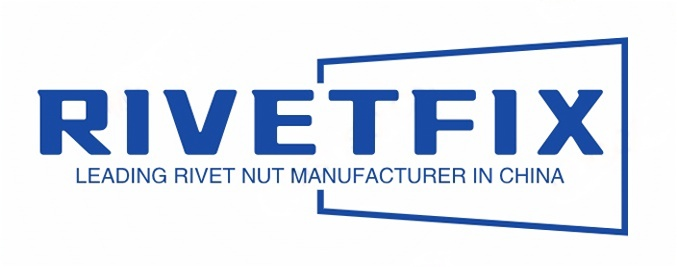
If you’re looking for high-quality rivet nuts or rivet nut tools, Rivetfix is an excellent choice. As a leading supplier of rivet nuts, Rivetfix offers a wide range of options to meet various industrial needs. Whether you’re working on machinery, automotive, aerospace, or DIY projects, Rivetfix provides reliable products that ensure secure and durable connections.
Why Choose Rivetfix?
- Quality and Reliability: Rivetfix is known for its commitment to quality, ensuring every product meets international standards like ISO and DIN.
- Variety: A wide selection of materials, sizes, and types of rivet nuts and tools to fit specific application requirements.
- Competitive Pricing: Rivetfix offers competitive pricing, particularly for bulk orders, helping you stay within budget without compromising on quality.
- Excellent Customer Support: With a focus on customer satisfaction, Rivetfix provides responsive support to help you find the right solutions for your project needs.
For your rivet nut needs, consider Rivetfix to get reliable and high-performance products.
Get High Quality Rivet Nuts Quote!
Send Your Rivet Nut Request
For more than 20 years, Rivetfix has helped customers solve many rivet nuts sourcing needs and technical challenges.
Have a question? Contact us and we’ll provide you with the perfect solution.

